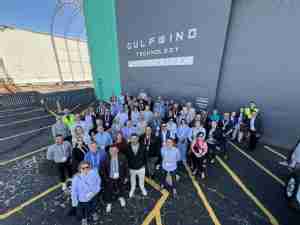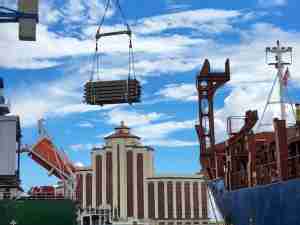Under the theme “Building Bridges - Raising Economies,” federal, state and local officials gathered near the base of the existing Gerald Desmond Bridge for a ceremony that included two helicopters hovering at 515 feet – the eventual height of the two new towers. The new bridge will allow the world’s biggest cargo ships to reach the inner berths at the Port of Long Beach and simultaneously expand a strategic highway that carries 15 percent of all goods coming into the U.S.
"This bridge is vital to freight movement and the nation’s economy,” said Federal Highway Administrator Victor Mendez. “The project will also relieve congestion on the road network that directly serves one of the nation’s busiest ports.”
“This new bridge will be a monument to the power of partnerships,” said Caltrans Director Malcolm Dougherty. “Everyone stepped up to the plate to make this a reality – the state, the port, the federal government, the local transportation agency and the construction industry.”
With the twin 50-story-high towers, the new bridge will be one of the tallest cable-stayed bridges in the United States and the first of its kind in California. The “high-wire” aerial demonstration by the helicopters gave attendees at today’s ceremony an idea of the eventual grandeur of a bridge expected to provide an exciting new feature to the Southern California skyline.
“A world-class bridge will serve as a long-term investment in our Port and create a new West Coast icon,” said Long Beach Mayor Bob Foster. “The Gerald Desmond Bridge Replacement Project is vital to our city, to our state and to our nation. This new bridge will bring lasting, positive economic impacts across many sectors.”
The replacement project will allow the Gerald Desmond Bridge to remain in use while the new bridge is erected adjacent to it. The new bridge is among $4.5 billion in current and planned improvements to further modernize the Port of Long Beach and keep it competitive. Work on the new bridge will generate, on average, 3,000 jobs a year during construction.
The new bridge will raise the clearance over the channel from 155 feet to 200 feet, allowing the world’s largest ships to enter the Port’s inner harbor.
“A new bridge is vital to our port tenants, to our communities and to businesses around the world that depend on us to move their goods,” said Port of Long Beach Executive Director J. Christopher Lytle. “The new bridge will be a shining beacon for the world to see that we intend to remain a very modern port.”
With deep channels and tall cranes, the Port of Long Beach already is serving the world’s biggest cargo ships at some of its piers, but the height of the Gerald Desmond Bridge restricts these large ships from entering the inner channels.
The new bridge also will improve speed and efficiency for land-based cargo movement and commuters. Commuters account for three-quarters of bridge traffic, which is nearly 70,000 daily vehicle trips. The Gerald Desmond Bridge, which opened in 1968, provides a critical link from Terminal Island and the ports of Long Beach and Los Angeles to downtown Long Beach and the 710 Freeway.
Other features of the new bridge include a bike path, pedestrian path and scenic observation decks 200 feet above the water. Construction costs on the new bridge will be about $650 million, with site preparation, demolition of the existing bridge and other considerations bringing the total project to $1 billion.
This project is a joint effort of the California Department of Transportation and the Port of Long Beach with funding also from the U.S. Department of Transportation and the Los Angeles County Metropolitan Transportation Authority.
“Replacing the Gerald Desmond is critical to enhancing the safety of mot









